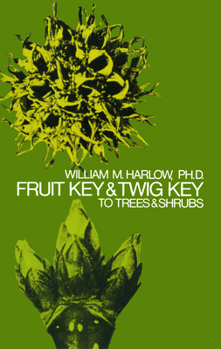Fruit Key and Twig Key to Trees and Shrubs
Select Format
Select Condition 
Book Overview
These handy, accurate, and easily used keys to fruit and twig identification are the only guides of their sort with photographs -- over 350 of them, of nearly every twig and fruit described -- making them especially valuable to the novice. The fruit key (dealing with both deciduous trees and evergreens) begins with a concise introduction, explaining simply and lucidly the process of seeding, and identifying the various organs involved: the cones and flowers, and their component parts and variations. Next the various types of fruits are described -- drupe, berry, pome, legume, follicle, capsule, achene, samara, nut -- and fruiting habits, followed by a synoptic summary of fruit types. The introduction to the twig key tells in plain language the process of growth and its relation to twig morphology through leaf scars, branch scars, buds, etc. For the benefit of the unwary, poison-ivy, poison-oak and poison-sumac are immediately and fully described. Identification in both books is easy. There is a pair of alternative descriptions of each aspect of the specimens. Your choice of the fitting one leads you automatically to the next proper pair. At the end of the chain is the name of your specimen and, as a double check, a photograph. More than 120 different fruits and 160 different twigs are distinguished. This exceptional work, widely used in university courses in botany, biology, forestry, etc., is a valuable tool and instructor to the naturalist, woodsman, or farmer, and to anyone who has wondered about the name of a leafless tree in winter or been intrigued by an interestingly shaped fruit or seed.
Format:Paperback
Language:English
ISBN:0486205118
ISBN13:9780486205113
Release Date:June 1959
Publisher:Dover Publications
Length:128 Pages
Weight:0.45 lbs.
Dimensions:0.3" x 5.4" x 8.5"
Customer Reviews
5 ratings
For eastern North America
Published by Thriftbooks.com User , 17 years ago
The book is an unaltered reprint combining "Fruit Key to Northeastern Trees" (1946) and "Twig Key to the Deciduous Woody Plants of Eastern North America" (1954). The reprint title led me to assume that the geographic range it would cover would be a little bit more expansive. I live in the western United States so as a field guide the book isn't something I would use very often. That being said there is a good level of detail with magnified photographs for each specimen.
A classic
Published by Thriftbooks.com User , 17 years ago
No one - no one, should study dendrology in the northeastern US without this book. It is an absolutely essential reference. At the price for this book, even new, you can't afford to be without it. Buy a copy now...you need it!
If you can only have one winter key, this is it
Published by Thriftbooks.com User , 19 years ago
This is one of three winter keys I use on a regular basis. I work at a botanical garden, but I'm not a botanist. I find it easy to use, and fairly comprehensive. It uses B/W photos instead of line drawings- this works great for the fruit key. For the twig key, drawings might have been clearer, but it's still very good. The first ten pages cover the terminology used in the rest of the book, and are a good introduction. There are seperate indexes for common & scientific name. One caveat: each of the two sections (twig, fruit) has its own set of indexes. When I brought this key to work, both my boss (a horticulturalist) and our head gardener ( a botanist ) produced well-worn copies of their own, so it's been around awhile, and has stood the test of time.
What to do till spring comes
Published by Thriftbooks.com User , 22 years ago
If you're a tyro or a practiced botanist, you'll find this helpful. Take it along on walks in the dreary seasons, and you'll find a wealth of fascinating things to keep you busy bushwatching. Easy to use and not too technical.
a technical field guide
Published by Thriftbooks.com User , 26 years ago
This is the guide I take with me on walks in the winter, when all the leaves are off the oak forest here in southeast Massachusetts. To be honest, I haven't had an opportunity to use the fruit key yet. Remember that this book is ONLY a key, so you'll need other references to learn. I've found the key to be technical and a bit unwieldy on occasion, but by the same token, it's opened a new level of detail to my observation: an eye loupe comes along for those walks...






